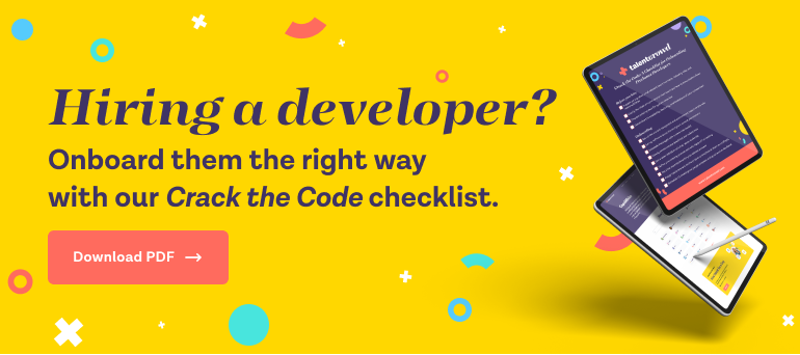Do you need to hire developers? Have you already started gearing up for the hiring process and wondered, "what did I get myself into?"
You are not alone! Interviewing and hiring developers can be a daunting task, even for the most experienced person. In a survey of technology leaders, 86% reported that it is a challenge to find technical professionals today.
Why is this the reality?
Of all the jobs in different sectors and industries, a developer position is one of the most difficult roles to fill. Software development and engineering are very technical and require specialized skills and knowledge. Finding the right developer that meets all the criteria can take time, and requires an invested effort.
In addition, there is currently a shortage of developers. As of 2021, the talent shortage amounted to 40 million skilled workers across the globe, and it is expected to rise to 85 million by the year 2030. With such a significant lack of talent, the job market is highly competitive. There will always be another company that can offer better incentives, higher salary potential, or a more desirable location. This makes finding and retaining developers even more challenging than what is typical.
The interview process for any business, but especially for software development, is key to attracting and hiring the right candidate. If you are currently searching for technical talent or just beginning the process, this article aims to be a helpful resource, and to provide all the information you need to feel competent and confident in your search for a great developer.
Read on for a step-by-step guide for interviewing developers.
Before You Begin
The very first thing that needs to be done is to make sure you are fully prepared for what is ahead. The interview process is extremely important, and it's not something that should be rushed. If you're in too much of a hurry, you run the risk of missing great developers and possibly making the wrong hire.
Hiring the wrong developer can be detrimental to your business and your development team. It wastes valuable resources such as time and money.
According to the U.S. Department of Labor, a bad hire can cost up to 30% of their annual salary. Between recruitment, training, benefits, and salary, costs add up quickly. These costs are repeated if the employee must be replaced, and the hiring process is started all over again.
It also wastes time and energy because co-workers need to pick up the slack. This can cause an increase in workload and a drop in morale and engagement. As a result, top-performing employees may decide to leave. Once again, you'll be back to the drawing board, interviewing developers.
All of this can be avoided if you prepare and plan well for the interview process.
First, Establish a Structured Interview Process
Having a system in place is critical for accurately identifying the best job candidates. The selection process for a software engineer is usually carried out in specific stages. Here is what the hiring process will potentially look like:
Submitting the Job Listing
A compelling job listing is key to attracting top talent. After evaluating the job and its requirements, the open position will be advertised for any potential candidate to submit their resume and supporting materials.
Sorting through Applicants
Once your job listing has sufficient responses, resumes and supporting materials will be reviewed by the hiring manager or the hiring team, depending on how many people are involved. Promising applicants that meet all the requirements will be selected for the next step.
Screening Interviews
An introductory phone interview will be held for each candidate. This helps to evaluate their fit for the job and eliminate any unqualified software engineers.
Skill Assessment
Candidates who impress during their phone interview will be invited to complete a coding challenge, either at home or in person. This gives you the ability to gauge their competency and technical skills in a real-life scenario.
Secondary Interviews
Those that performed well on the coding challenges will move on to a final interview. This one is more in-depth than the screening interview, and it gives you the opportunity to fully assess all of their personal and professional qualities.
Selecting the Candidate
After the secondary interviews, the hiring team should be able to make an informed decision about who is the best fit for the programming job. A job offer is extended and if they accept, the job interview process is complete.
The processes and procedures can vary depending on the company, and it's important to tailor it specifically to your needs.
Second, Build a Hiring Team
Once you have set up a system for your developer interviews, you need to decide who will be involved. If you are working with a recruiter or an HR person, they might have their own requirements or suggestions, and they may or may not be present in all stages. But you should consider for yourself what the ideal hiring team looks like for you.
At least one experienced developer should be featured. This is non-negotiable as each developer needs to be evaluated by someone with technical knowledge. The candidate's potential boss should be involved too. What about the boss's boss? Does the CTO (chief technology officer) need to be included? If the job opening is a manager position, what about possible future employees? Would it be advantageous to invite the team lead or other team members? Oftentimes, they know better than anyone else what kind of manager they need.
Building the perfect hiring team can look different depending on the nature of the open position, which makes it important to consider all aspects beforehand.
Third, Set a Goal
After the hiring team is established, it's necessary to define your purpose. Obviously, the main intent is to find and hire the best software developer. However, that is a broad objective and has different meanings to different people. Be specific. What would make this person the right fit? What programming languages would the perfect candidate know? What attributes would they possess? Cultural fit is just as important as software development abilities. Make a list of all the qualifications, including soft and hard skills, that you are looking for:
Hard Skills
Hard skills are the technical skills that are needed to accomplish certain tasks. For software engineers, this means mastering essential programming languages such as Java, Python, or C++. It also includes developing, testing, maintenance, and repair of software.
Soft Skills
Soft skills are common skills or interpersonal attributes that apply to all professions. Examples of these are strong written and oral communication, critical thinking, time management, and teamwork.
Be certain of what your requirements are before starting the search for candidates.
Lastly, Brainstorm Interview Questions
Your hiring team should create a predetermined list of questions to ask each candidate during both the screening interviews and final interviews. The same questions should be asked to each individual, and they should be relevant to the specific job. Examples of appropriate questions to ask will be provided further on.
Once you have prepared yourself by establishing a system, building the hiring team, establishing a goal, and creating a list of questions, you will be ready to embark on the actual interview process.
Step 1: Create and Post the Job Listing
Depending on your company, a recruiter or a hiring manager will most likely oversee this first step. Even so, you may be consulted about the job description and expectations for a new hire.
Attracting the best software developers starts with a strong job listing. It should be direct, clear, and brief. The ideal job listing would follow a similar structure to this sample:
Job Summary
In the first section, provide a short overview of the company, and its purpose and values. Give the job title, general details about the position, and what the company is looking for in a developer.
Duties and Responsibilities
In this section, list all of the day-to-day tasks. Will they collaborate with other internal teams? Do they interact with clients to resolve issues? Are they expected to create entirely new software or maintain existing ones? If it is something that they will do on a regular basis, it should be listed.
Qualifications and Requirements
For this section, supply the applicant with all the expectations for the developer who fills the position. Being thorough will help to draw the attention of the most qualified candidates. List any coding languages or frameworks that they need working knowledge of. Include requirements such as excellent communication skills, creativity, problem-solving, etc. You should also list any education, training, or experience that is preferred. It's recommended that these qualifications are described as "preferred" rather than mandatory, so that you don't miss out on a highly skilled software engineer with an unconventional background.
Benefits
Depending on the state, salary transparency may or may not be a requirement. Regardless if it's mandatory, you should consider disclosing the benefits and salary range upfront. It can serve as an incentive to apply. It can also weed out applicants who would require a higher salary than you are able to negotiate.
After the listing has been posted for job seekers to apply, it is time to move on to the next step.
Step 2: Select the Best Applicants
The next step in the hiring process begins after you've received a sufficient amount of applications in response to your job posting. If you are working alongside a recruiter, they will help to sift out any obviously unqualified candidates, which narrows down the pool and frees you up to review only promising resumes.
It's important to remain fair and unbiased during this step. Remember your list of qualifications that you created, and refer back to it often. These are the only standards to which all applicants should be held, which helps to eliminate any unconscious biases.
Another way to reduce unfairness is to go in “blind” for the resume review. Blind recruitment is removing all identifying details from the candidates' applications and resumes. The only information you view is relevant to your list of requirements and qualifications.
As well as being unbiased, it's important to be open to those with nontraditional backgrounds. Certifications and degrees are important but not entirely indicative of a candidate's potential for future success. A growing number of software engineers take a nonconventional route and do not possess a computer science degree. If you overlook them during the interview process, it can cause you to miss out on very capable talent.
Being fair and open-minded will diversify the candidate pool and increase your chances of finding the perfect fit.
After you have narrowed down your list and made your selections, it's time to invite them to a job interview. This can be done either over the phone or through email. Choose the method that aligns more closely with your company culture. For either option, the format should generally be the same.
You can use this script either in an email or as a guide to follow during a phone conversation:
Hi (Name),
My name is (your Name), and I am the (job title) at (Company).
Thank you for your interest in our open (job title) position.
We received your application and would like to invite you to a short phone interview. The interview will last about 30 minutes, and we want to focus on getting to know you better and telling you a little more about the job.
Please let me know which of the following options works for you, and I can send a confirmation email with more specific details:
(List several alternative dates and times)
If these options don't work for you, let me know your availability, and we will do our best to coordinate with your schedule.
Feel free to ask any questions that should arise during this process.
Looking forward to talking with you,
(Your Name)
Be sure to send the follow-up email immediately afterward. Include as much information as possible and explain the process so they can feel prepared and less pressured.
Step 3: Hold Screening Interviews
This is where the real work of interviewing developers begins. Screening interviews are held over the phone. The goal of the screening interview is to learn about each candidate and their character, to understand their desires, and see how those align with your requirements. These are usually held over the phone. It should be short and concise; try to keep it under 30 minutes.
As you interview developers, remember that they are interviewing you as well. They are evaluating whether or not the company and job position would be a good fit for them. First impressions are extremely important. Here are a few tips to keep in mind:
Be on Time
Something so simple can be tremendously meaningful. Being punctual shows that you respect the candidate and care about their time. To make sure you don't run late, schedule a block of time in between each interview to regroup, make notes, and give yourself a cushion in case one interview goes longer than expected.
Be Personal and Positive
Because you are speaking over the phone, certain non-verbal social cues can't be relied upon. The candidates can't see facial expressions, body language, or hand motions. Your tone of voice is important. Smiling affects how you speak and can be perceived over the phone, so try to do it often. Be pleasant, friendly, and personable to set interviewees at ease and ensure a positive experience.
Communicate Clearly
This beginning stage of developer interviews is when you need to convey what you are looking for, as clearly as possible. Talk about the requirements and expectations, and encourage them to share their own expectations. If those expectations don't align, you won't waste anyone's time by continuing with the technical interviews. Share about the company culture and values as well, because the right fit should be someone of the same mindset.
Do Your Research
Make sure to have the resume and application readily available for each developer interview. You want to know their names and be familiar with their backgrounds before they answer the phone. Be prepared to answer any questions about the job or the company.
Speaking of questions, be sure to have on hand your list of predetermined questions for screening interviews. You should ask the same questions in the exact order to each candidate to be completely fair and unbiased. These questions should mostly be introductory. Questions you might ask include:
- Can you tell me about yourself?
- Why are you interested in this position?
- Can you describe your current or most recent role?
- What is your ideal work environment?
- What are your salary requirements?
- Do you have any questions for me?
Ask open-ended questions and listen well. Candidates who impress during this part of the interview process will move on to the next step, which is an evaluation of their technical skills.
Step 4: Invite Candidates to a Skill Assessment
Would it really be a technical interview without a technical test? A major part of developer interviews is having them prove their skills through a coding challenge. This allows you to evaluate a candidate's knowledge in their area of expertise.
There are several methods for conducting coding challenges. Each one has different advantages, and there's no one right way. Three of the most commonly used methods are as follows:
Whiteboard Testing
In a whiteboard test, candidates solve a coding challenge on a whiteboard in front of interviewers. The benefit of this is that it's interactive. It's more of a productive conversation that gives you insight into the developer's thought process, how they gather information, how they deal with criticism or feedback, and how well they can describe complex ideas. The downfall is that it can feel like a high-pressure situation and can cause performance anxiety. Unless a candidate thrives in the spotlight, this method could deter talented developers from continuing through the interview process, or cause them to not perform as well as they would in a less stressful situation.
Pair-Programming
Pair programming is when the interviewee and the interviewer solve a coding challenge together on a shared platform. One person writes code while the other reviews, and they can switch roles. It is less of a performance than a whiteboard test, and more of a collaboration. This is ideal when the technical interview is for a position with extensive teamwork. Not only are coding skills put to the test, but communication skills are too.
Take-Home Challenges
For a take-home coding challenge, candidates complete the task at home and at their own pace. It is especially beneficial if you are hiring for a remote position since they will be working in a real-life setting. It can bring out the best in each candidate and accurately reflect their abilities because it's comfortable and it simulates a more realistic task. For the best results, limit the amount of time they are allowed to spend on the test. Three or four hours is average. Also, choose the language or framework that your development team uses on the job.
For any coding challenge method, it should not be a pass or fail test. You should assess candidate results based on your list of qualifications and characteristics. This is the phase of technical interviews where having an experienced developer on your hiring team is of utmost importance. Here are a few key things to look for in coding challenges:
- Clear communication
- Attention to detail
- Time management
- Code functionality
- Code quality
The coding challenge should narrow down your pool of potential candidates significantly. The developers who performed best on their assessments will be invited back for the next phase of technical interviews: the final interview.
Step 5: Hold Secondary Interviews
Secondary interviews, or the final interview, can either be on-site or virtual, depending on your specific situation. Either way, the purpose of this step is to find one candidate who will become the new team member. Having a positive experience for all parties involved can be achieved with the right environment and great interview questions.
Whether the developer interview is held in person or virtually, the same factors help to create the best environment.
Be thorough in your communication regarding time and location to each candidate. If it's a virtual interview, send clear instructions on how to join the group so there is no confusion on their part. The last thing they need is to be flustered beforehand. If it's in-person, give driving directions, instructions on parking, and an outline of the building so they know exactly where to go.
Interviews should be held in a quiet location. Make sure there are no distractions so that everyone can focus and be attentive. Not only should the interview room be quiet, but it should be welcoming. This can be achieved by simple gestures such as offering water (if applicable), being warm and friendly, and having a positive attitude.
Interviews should be scheduled with plenty of time in between. This allows you space to reset and refocus between candidates. Your team of interviewers can compare notes immediately after a candidate leaves so their observations are still fresh. If an interview goes longer than expected, it also ensures that it doesn't push back the following interview time.
Be prepared with blank note paper, a pen or pencil, resumes and relevant material, and your list of prepared questions. Make sure the whole team of interviewers has the list of interview questions to refer to. Just as in the screening interview, the same questions need to be asked to every candidate in a standardized way. It doesn't need to be rigid and robotic. Allow the conversation to flow naturally, ask follow up questions, and let the candidates talk.
Have both technical and behavioral questions on your list. What are some good questions to ask?
- What made you choose software development as a career?
- What programming languages do you prefer?
- Can you tell me about a successful project?
- Can you describe your typical development process?
- Can you tell me about a mistake that you learned from?
- What are some projects you’re currently working on?
- How do you guarantee software quality?
- How do you like to give and receive criticism or feedback?
- What are your career goals?
- How do you make sure your skills are sharp and up to date?
- What work achievement are you most proud of?
- Where do you want to be in five years?
- What questions do you have for me?
As you interview developers, put more emphasis on accomplishments and experience rather than what tools or programming language they know. Having knowledge is not the same thing as having skills.
This step completes the actual technical interview process, and the final step is to identify the top candidate who you want on your engineering team.
Step 6: Extend a Job Offer
This final part concludes the interview process. Hopefully, you will have found the perfect fit for your development team and can send them a job offer.
Along with reaching out to your chosen candidate, it is recommended to contact the other candidates. Whether or not you hire someone, their experience with your company matters. As you interview developers, you may come across someone who may not be the right fit for this job, but they're perfect for another position. Or they might have a large number of contacts within software engineering. Sixty-two percent of job applicants who are satisfied with their interview experience, regardless if they were hired, are likely to recommend the company to others.
Part of making sure everyone has a positive interview experience is not disregarding them after the job interviews have ended. Send them an email to let them know the position was filled. Thank them for their time, offer feedback, and request more information about their experience so you can continue to improve your process of interviewing developers.
Here's a suggested template to follow:
Hi (Name),
Thank you for your interest in the (job title) position at (Company), and for taking the time to interview with us.
We would like to inform you that we have decided to move forward with another candidate.
We were impressed by (feedback) and appreciated (more feedback). Unfortunately, we were looking for (feedback) for this position.
However, we enjoyed getting to know you and learning about your qualifications. We believe you may be a good fit for future job openings, so we would like to keep your resume on file in case the opportunity arises.
We welcome any feedback you may have about your interview experience. Please feel free to reach out with any questions as well.
Thank you again for your interest.
We wish you the best in your job search,
(Your Name)
In Conclusion
With the growing shortage of technical talent, along with the time and effort it takes to interview developers, this task can seem daunting. Hopefully, this article is a helpful source that provides you with guidance and reassurance.
If you find yourself still overwhelmed with the process of interviewing developers, it's not the only way.
Talentcrowd is a digital talent platform that specializes in providing businesses with highly skilled and talented technology teams. It has already done all the hard work to find the best and most qualified developers.
Every developer with Talentcrowd is tested extensively on programming languages, algorithms, frameworks, and more. Not only are their hard skills verified, but they are screened on skills such as attitude, energy, and values to ensure that they will be valuable, trustworthy team members.
Upon partnering with Talentcrowd, you receive immediate access to relevant, quality expertise and a wide range of skills and knowledge. Each team is tailored specifically for your company and its specific projects, and these teams can be scaled up or down depending on your needs. There is no project too big or too small.
Developers are outsourced, fully remote, and based in North America. Working with them allows you to focus on core responsibilities, and the outsourced team will integrate seamlessly so you can collaborate with them as easily as with an in-house team.
Finding and hiring developers doesn't have to be hard. If you are currently conducting software developer interviews or just beginning the process, you can refer to this article to help guide and inform you through the hiring process. Or you can avoid the strenuous process of interviewing developers and use Talentcrowd to outsource your technology team.
Hire top technical talent with Talentcrowd today!




